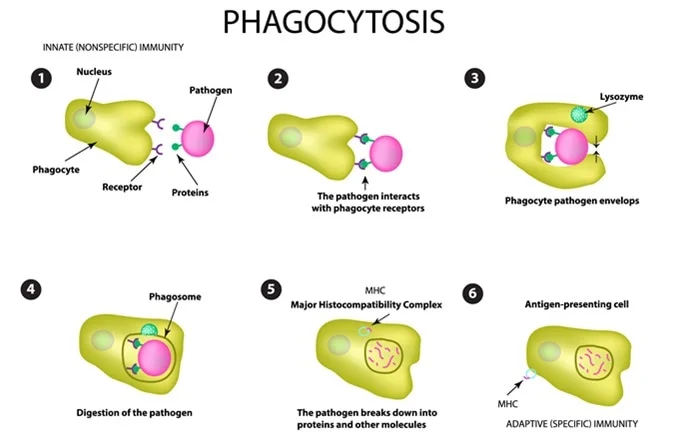microorganisms in relation to human health: chapter 4
The problem of antibiotic resistance
%%superbugs%% = strains of bacteria, viruses, parasites and fungi that are resistant to most of the antibiotics and other medications commonly used to treat the infections they cause.
→ are mutants who after frequent contact with antibiotics for example changed their DNA → become insensitive to the antibiotic → break it down or render it harmless
example: MRSA
The defense mechanisms of our body against microorganisms
immune system
%%non-specific defense%% = the body’s first line of defense against diseases. They are not directed against a particular pathogen.
%%skin%% = a barrier with the outside world → protects the body in 3 ways of parasat=ic microorganisms
The stratum corneum = the outermost layer of the epidermis
The sebaceous and sweat glands secrete acidic and antibacterial substances
Body’s bacteria compete with foreign bacteria
%%mucous membrane%%
epidermis of body cavities is much thinner than the other skin but is also in direct contact with the outside world →mucous glands protect it →create a thin layer of mucus to prevent access to the underlying tissue
%%white blood cells and cell signaling%%
%%Macrophages%% = specialised cells that are involved in the detection, phagocytosis and destruction of bacteria and other harmful organisms
%%phagocytosis%% = The process by which a phagocyte (a type of white blood cell) surrounds and destroys foreign substances (such as bacteria) and removes dead cells.
example:
1. Bacteria penetrate the skin via a wound2. Macrophages leave the capillaries to attack the bacteria 3. Macrophages phagocyte the bacteria and digest them
%%Natural killer cells/ NK-cells%% = a special type of white blood cells that produce perforin that open and drain infected body cells
%%perforin%% = a protein, released by killer cells of the immune system, which destroys targeted cells by creating lesions like pores in their membranes.
%%Signaling molecules%% → secreted by infected cells → 2 important functions
- attract macrophages and activate NK-cells
- warn other cells to create a protein → prevent multiplication of microorganim
%%specific defense%% = consists of mechanisms and agents that target specific antigens
- characteristics
%%The detection of antigens%%
%%antigen%% = a specific molecule (a protein) found in the cell membrane of all cells of any organism (including in the protein coat of a virus)
- via antigens → immunesystem can recognise foreign cells and viruses = %%T- and B-lymphocytes%% → recognise antigen
- cell membrane lymphocytes have receptor molecules →ability to bind to the antigen = key-lock-principle
%%building memory%%
after an infection → body produces memory lymphocytes → new infection with same microorganism → faster detection → faster reaction of immunesystem → no sickness → immunity gained
- %%functions of T-cells or T-lymphocytes%%
- have membrane receptors to recognise infected cells → bind with it → perforate cell → cell dies
- T-cells keep on multiplying upon contact → some turn into memory T-cells
- T-cells produce signaling molecules → stimulate B-lymphocyte production
- %%functions of B-cells or B-lymphocytes%%
- recognise antigens → produce antibodies → bind with antigen → create antigen antibody complex →macrophages clean it up
- B-cells keep on multiplying upon contact → some turn into memory B-cells
How to keep or increase your resistance?
- get enough sleep
- excercise regularly
- have a balanced diet
- avoid smoking, drugs and excessive alcohol consumption
- be cautious with the use of medicines
Immunisation
- %%active immunisation → vaccines%%
- injection of dead or weakened pathogens → encourage the body to make memory cells and antibodies
- %%passive immunisation → serum therapy%%
- injection of anitiserum → presence of antibodies → patient doesn’t produce them → no production of memory cells